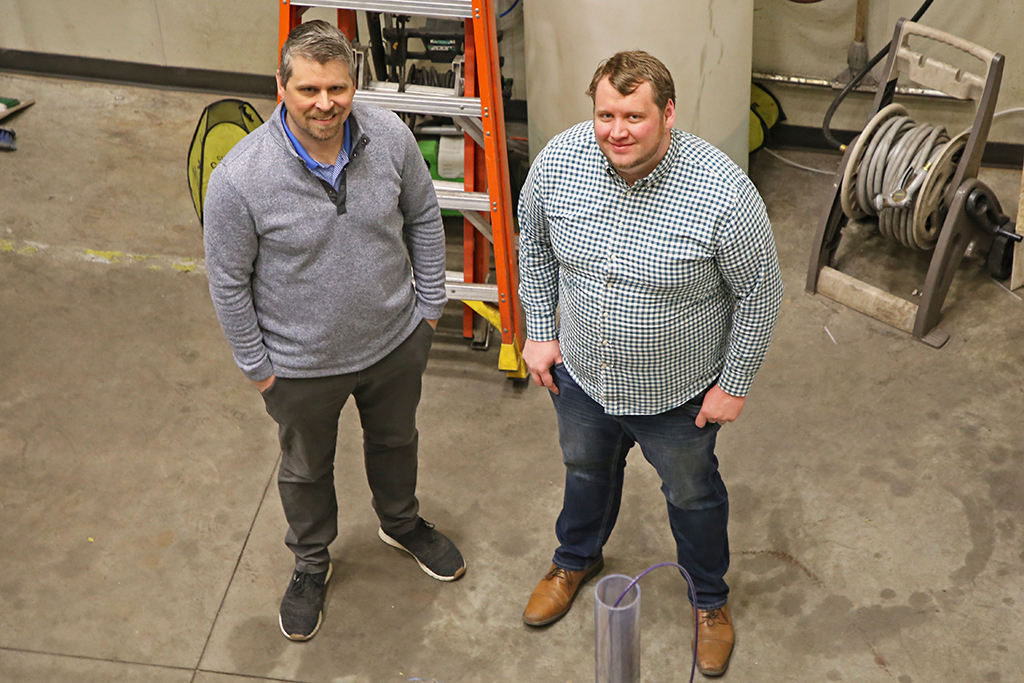UND researchers hit milestone in rare-earth minerals production
Focus on extraction in North Dakota moves from conceptual to commercial

Efforts by UND researchers to transform the state into a hub to produce rare earth elements (REEs) and critical minerals (CMs) continue to move forward, and the pilot production facility, located off Mill Road in Grand Forks, has begun to produce concentrated mixtures of the compounds.
This most recent development comes on the heels of a high-level visit of federal energy leaders. The delegation came to North Dakota in mid-October to tour the facility and a lignite coal mine near Underwood, N.D. The visitors included members of the National Energy Technology Laboratory (NETL) and leaders from the U.S. Department of Energy’s Office of Fossil Energy and Carbon Management (FECM), Office of Manufacturing and Energy Supply Chains and Office of International Affairs.
The visit was significant because it allowed the federal decision makers to get a first-hand look at UND’s pilot extraction facility, said Nolan Theaker, senior research manager with the Research Institute at the UND College of Engineering & Mines.
“This event was the highest number and highest rank of DOE representatives to date who have visited campus for this project, and they represent some of the key decision makers at DOE for making a commercial project a reality,” he said.
Moreover, Theaker said, the visit focused on the practical future of extracting REEs in the state, rather than the theoretical.
“This visit wasn’t purely about technology discovery anymore. Instead, it was about how this process could be built as a commercial effort.”
The visit by federal leaders came roughly six months after UND was awarded an $8 million DOE grant to explore the possibilities of REE production in North Dakota. The grant is part of a federal effort to produce those elements inside the United States, as most of the elements currently are produced in China. This puts the nation’s supply at risk should China curtail exports of the elements.
Critical minerals are used in a wide variety of electrical products, including smartphones and electric vehicles, as well as industrial magnets. Notably, they’re also a crucial part of the nation’s national defense supply chain.
The DOE grant is helping UND researchers explore the viability of producing REEs from North Dakota lignite coal, and is Phase 1 of a two-phase federal program to build an REE extraction facility somewhere in the United States. Moving to Phase 2 means unlocking an additional $134 million in DOE funding to build the facility.
UND and North Dakota are in competition with West Virginia University and West Virginia to be the host site of the facility.
Now, UND’s pilot extraction facility is producing concentrated batches of REEs. According to Nicholas Dyrstad-Cincotta, research operations manager with the Research Institute at the UND College of Engineering & Mines, researchers have produced nearly 10 pounds of concentrated REEs, which he called a “major milestone’ at the pilot level.
Testing is now underway on that concentrate, and Dyrstad-Cincotta said researchers are preparing to produce a second batch.
Dyrstad-Cincotta said the challenge of building a pilot extraction facility was daunting when it was first proposed, but he has not encountered a problem he and his team could not solve.
“Getting this pilot plant operational is a monumental achievement for our department and the College of Engineering and Mines,” he said. “Two years ago, this pilot plant only existed on paper. Today, we have a functional pilot scale engineering research facility that the College can study and use as leverage for future projects for years to come.”
Actually producing REEs and the October visit by federal energy leaders represent a significant step forward for REE production in North Dakota. Dan Laudal, executive director and research professor with the College of Engineering & Mines, previously told UND Today that securing the funding to build a commercial extraction facility in the state could bring a completely new set of industries to North Dakota and transform part of the state’s mining economy while creating new jobs.
Theaker said he was grateful to showcase UND’s REE production efforts to the NETL, Office of Fossil Energy and Carbon Management, and other DOE visitors in October. That visit was also joined by Mike Holmes from the North Dakota Industrial Commission’s Lignite Research Program.
Theaker said the energy leaders were impressed by the commitment and dedication to this project by UND and commercial partners, state agencies and the Legislature.
“I’d just like to thank everyone in this great state that continues to push to make this project a reality,” he said.
Like Laudal, Theaker stressed the economic benefits of producing REEs in North Dakota, which would then extend to the rest of the nation.
“Our message is not one of exploiting a resource for one specific benefit or company, but to develop a new mineral processing and materials industry in the state,” he said. “This first plant could produce products that could be sold to over 40 different companies and industries throughout their supply chain, and the possibilities are likely to continue to grow.”
Editor’s note: In April, UND Today talked Laudal and Theaker and produced a Q&A that expands on the significance of producing REEs in North Dakota. That article can be found on the UND Today website.
In addition, an account of the visit by NETL and DOE leaders can be found on the NETL website, and a recent MPR News article offer additional insights.
Written by Adam Kurtz // UND Today


